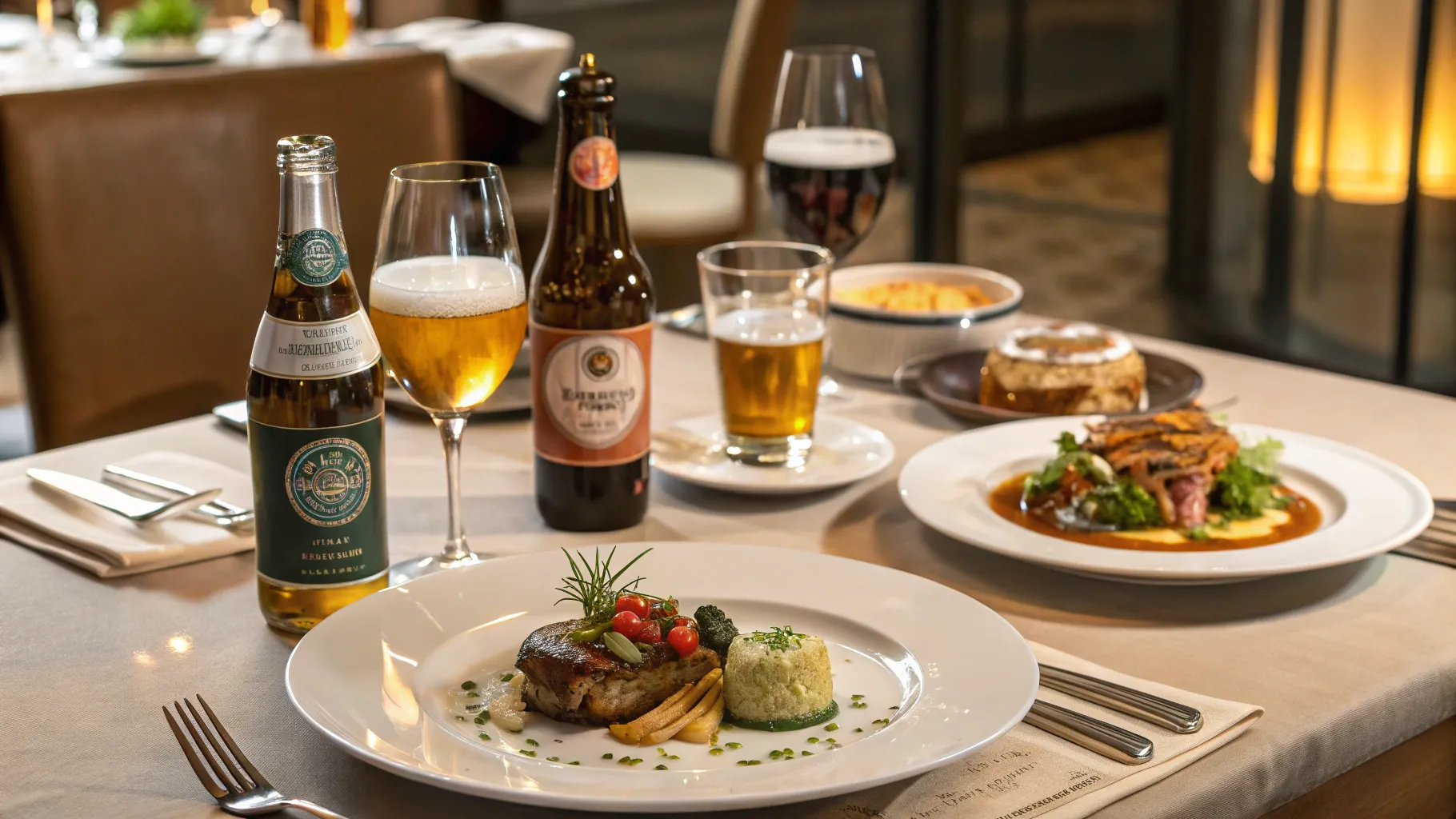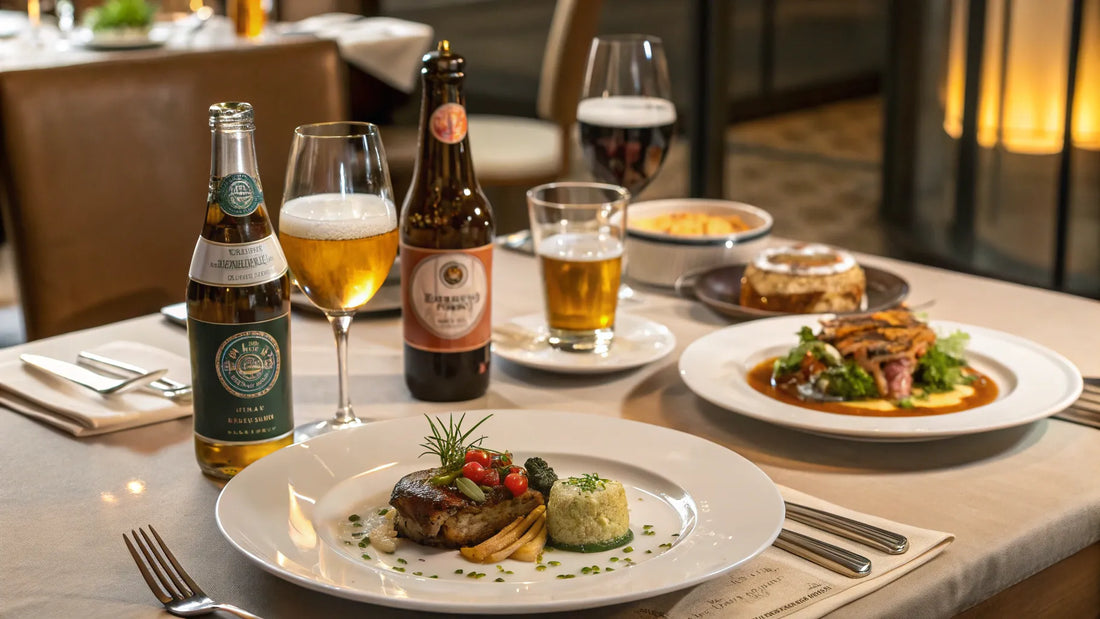Is beer better than wine with food?

In this article, we dive into the world of beer and food pairings, led by chef Adam Dulye from the Brewers Association. We explore why beer is often excluded from the fine dining experience and how we can get it back on the menu. With a four-course beer dinner as a backdrop, we discuss the art of pairing beer with different dishes.
🌍 Introduction to the World of Beer and Food
"Beer and food have always been connected. In history, people drank beer as a safer alternative to water, which led to a natural combination with almost every meal. But how did it come to be that beer is often excluded from the fine dining experience today? Let's delve deeper into this fascinating relationship."
The art of pairing beer with food goes beyond simply choosing a drink for the meal. It requires an understanding of flavors, textures, and how they complement each other. From sweet malts that add depth and body to dishes to bitter hops that create complexity and a pleasant bite, the possibilities are endless.
The influence of culture and history
In many cultures, beer has always been an important part of the food culture. It is only in modern times that wine has gained the upper hand at the dining table. This has various reasons, including social status and the rise of the wine industry. But in recent years, the world of beer is starting to flourish again, and more and more chefs and brewers are exploring the possibilities of this combination.
🍻 The Basics of Beer and Food Pairings
To create a strong combination between beer and food, it is important to understand the different flavors and styles of beer. Each type of beer has unique properties that can enhance or balance the flavors of the food.
Essential principles of pairing
- Contrast: Combining flavors that complement each other, such as a bitter IPA with a rich dish.
- Agreements: Choosing beer types with similar flavors or aromas as the dish, such as a fruity Saison with a fruit salad.
- Texture: The carbonated properties of beer can help refresh the mouthfeel of richer dishes.
"It is also useful to experiment with different styles and flavors. This can lead to surprising and delicious combinations that stimulate your taste buds and enhance your eating experience."
🍷 Why Wine Has the Upper Hand
'Although beer has a rich history in gastronomy, wine has long been preferred at the dining table. This is related to various cultural and social factors. Wine is often seen as a more refined choice, while beer is sometimes considered inferior.'
The status of wine
Wine has a certain allure that beer often lacks. It is often associated with luxury and fine dining, while beer is sometimes seen as an everyday drink. This perception has led to a gap between beer and the culinary world.
Nevertheless, there are signs that this trend is changing. More restaurants are starting to take beer seriously as a full-fledged alternative to wine, and the number of beer and food pairing events is growing explosively. This is an important step towards reclaiming the place of beer at the dining table.
👨🍳 Who is Adam Dulye?
Adam Dulye is a prominent chef and an important figure in the world of beer and food pairings. As the executive chef of the Brewers Association, he advocates for the use of craft beer in gastronomy. His passion for cooking and brewing has led to innovative and flavorful combinations that continue to inspire the culinary world.
His philosophy and approach
Dulye believes that the connection between chefs and brewers is essential for creating unforgettable dining experiences. He encourages chefs to think outside the box and use beer as a powerful ingredient in their dishes. By collaborating with brewers, he can discover unique flavors and textures that elevate the dining experience to a higher level.
🎨 The Creative Connection Between Chefs and Brewers
The collaboration between chefs and brewers is crucial for creating innovative dishes that utilize the possibilities of beer. This creativity can lead to unique flavor combinations that enrich the dining experience.
Collaboration and innovation
By combining their strengths, chefs and brewers can explore new flavors and techniques. This can result in surprising dishes that transcend the traditional boundaries of beer and food pairings. It is an exciting time for both the culinary and beer worlds, where collaboration leads to new possibilities.
The future of beer and food pairings looks promising, with more and more chefs discovering the value of beer in their menus. The creativity and passion of both chefs and brewers will continue to contribute to a rich and diverse dining experience. This is just the beginning of an exciting journey in the world of beer and food.
📜 The Historical Role of Beer in Meals
Beer has played an important role in meals throughout history. In the past, it was a daily drink, often safer than water, and was consumed with every meal. From ancient civilizations to the Middle Ages, beer was an integral part of the dining experience.
In many cultures, beer was not only consumed but also used in the preparation of food. Think of stews, marinades, and even desserts. The versatility of beer in the kitchen has been recognized for centuries, but in modern times it has lost its place at the dining table.
The rise of wine as the refined choice has contributed to the marginalization of beer. While wine was embraced by the upper class, beer was often seen as a drink for the masses. This has led to beer disappearing from the fine dining experience. It is time to reverse this trend and rediscover the historical role of beer in our meals.
🌟 The Change in Culinary Trends
The culinary world is constantly in motion. In recent years, we have seen a shift in how we view food and drink. Chefs and brewers have become increasingly creative in their approach to flavors and combinations.
The focus is now more on authenticity and expressing personal style. Chefs cook what they want to cook, without worrying too much about traditional rules and expectations. This has led to an explosion of new flavors and techniques, with beer playing a prominent role.
Restaurants are experimenting with beer and creating unique pairings that highlight the power of this drink. The culture of fine dining is changing, shifting the emphasis from the elitism of wine to the accessibility and diversity of beer.
🚀 What is the New Culinary Revolution?
The new culinary revolution is about freeing chefs and brewers from traditional constraints. It's about allowing them to unleash their creativity and create dishes that are authentic to their style and taste.
In this revolution, there is room for experimentation. Chefs are not afraid to combine different cuisines and techniques, and the same goes for brewers. This leads to innovative dishes and beers that complement each other in ways we never thought possible.
The focus is not only on the end product, but also on the story behind it. It is about the connection between the food, the beer, and the people who consume it. This culinary revolution offers an exciting new perspective on how we enjoy our meals.
🎨 The Role of Creativity in Beer and Food
Creativity is the driving force behind the new wave of beer and food pairing. Chefs and brewers are working together to discover new flavors and textures. This collaboration leads to unique combinations that are both surprising and delicious.
By combining their creativity, chefs can create dishes that perfectly match specific types of beer. This requires a deep understanding of both the ingredients and the techniques used in both cooking and brewing.
The use of beer as an ingredient in dishes opens the door to endless possibilities. From using beer in marinades to creating desserts with beer as a base, creativity knows no bounds. It is an exciting time for both the culinary and beer worlds.
⚔️ Beer versus Wine: A Competition?
The discussion about beer versus wine is a much-debated topic in the culinary world. While wine is often seen as the traditional choice with meals, beer offers unique advantages that make it a serious competitor.
One of the main advantages of beer is the carbonation. This property can accentuate the flavors in a dish and provide a refreshing experience that wine cannot match. Beer has the ability to enhance and balance flavors in ways that wine cannot always do.
"However, it is not necessary to create a competition. Both drinks have their own unique qualities and can together provide a richer dining experience. The key is to find the right pairing, whether it is beer or wine. It is all about what works best for the specific dish and the taste preferences of the guest."
🔬 The Science Behind Combinations
The science of food and beer pairings is fascinating and complex. It all revolves around the interaction between flavors, aromas, and textures. When you combine beer and food, there are various elements at play. The balance between sweet, sour, bitter, and umami is crucial. A good understanding of these flavors can lead to surprising and delicious combinations.
An important aspect of this science is how the different components of beer, such as the bitterness of hops, the sweetness of malt, and the acidity of fermentation, can enhance or soften the flavors of food. The carbonation in beer can also help to refresh the mouthfeel, especially with richer or fattier dishes.
- Bitterness: Can balance the sweetness of a dish, as in combining a hoppy IPA with a sweet dessert.
- Sweetness: Can soften the sharpness of spicy dishes, for example by pairing a sweet bock with spicy Asian dishes.
- Carbonation: Helps to refresh the flavors and can accentuate the texture of a dish, such as when pairing a light lager with fried foods.
By understanding these principles, chefs and brewers can collaborate to create unique and unforgettable dining experiences.
🍖 The Perfect Combination: Meat and Beer
Meat and beer together form a classic combination that often takes center stage at a dinner. The richness and depth of meat dishes can be beautifully complemented by the right type of beer. Think of a robust stout that pairs perfectly with a juicy steak or a fruity ale that accentuates the flavors of marinated chicken.
Specific combinations to consider
- Red meat: A robust ale or a stout can complement the rich flavors of beef.
- Pork: A fruity bock or an amber ale can accentuate the sweetness of pork.
- Grilled chicken: A light, hoppy IPA can enhance the flavors of grilled chicken.
It's all about balance. The right combination can enhance the flavors in both the beer and the meat, elevating the dining experience to a higher level. It's an invitation to experiment with different styles and flavors.
💡 The Importance of Lightness in Meals
Lightness in meals is an essential aspect of modern gastronomy. While rich, heavy dishes often take precedence, there is a growing trend towards lighter, fresher options. This presents an excellent opportunity for beer to reclaim its place at the table.
When composing a menu, it is important to consider how the different dishes complement each other. Light beers, such as wheat beers or lagers, can refresh the flavors of a meal without overwhelming them.
Why choose lighter options?
- Refreshment: Light beers help to refresh the palate and can enhance the dining experience.
- Balance: Lighter dishes can pair better with a wider range of beer types.
- Accessibility: Light meals are often more appealing to a wider audience, which increases the opportunity to offer beer as a complementary drink.
By combining lighter dishes with suitable beers, chefs can create a balanced and enjoyable dining experience that will appeal to guests.
📈 The Change in Perception of Beer
The perception of beer has undergone a remarkable transformation in recent years. From an everyday drink, it has evolved into a valued option in the culinary world. This change is due to the rise of craft breweries and the creativity of modern chefs.
Factors that influence the perception of beer
- Craft breweries: The growth of craft breweries has led to a greater diversity of beers, which increases the appreciation for this beverage.
- Culinary collaboration: Chefs who take beer seriously and integrate it into their dishes have contributed to the revaluation of this drink.
- Consumer Experience: Guests are increasingly looking for unique dining experiences, where beer plays an important role.
This shift in perception offers an opportunity for both chefs and brewers to collaborate and explore the endless possibilities of beer in gastronomy.
🌐 The Future of Beer in Fine Dining
The future of beer in fine dining looks promising. With the growing acceptance of beer as a full-fledged alternative to wine, a new world of possibilities has emerged for both chefs and brewers.
What can we expect?
- Innovation: We will see more innovative dishes inspired by the diversity of beer.
- Education: Restaurants will place more emphasis on training staff about beer and the right pairings.
- Experiences: Guests will continue to seek unique dining experiences where beer plays a prominent role.
The collaboration between chefs and brewers will continue to grow, leading to a new wave of creativity and innovation in gastronomy. This is an exciting time for beer and food pairings, and the possibilities are endless.





